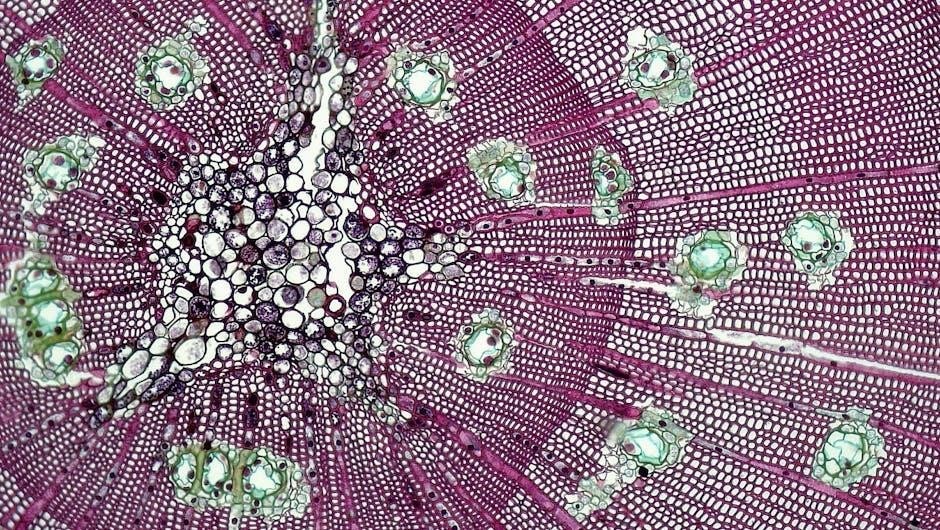AP Biology explores the intricate world of proteins, focusing on their structures and functions. POGIL activities enhance understanding of primary, secondary, tertiary, and quaternary structures through guided inquiry.
1.1 Overview of AP Biology
AP Biology is a rigorous, college-level course that explores the fundamental principles of life. It focuses on four big ideas: molecules, heredity, evolution, and biological systems. Students analyze complex biological concepts, including protein structure and function, through hands-on labs, case studies, and collaborative activities. POGIL (Process-Oriented Guided-Inquiry Learning) plays a key role, fostering critical thinking and teamwork. These activities guide students to explore protein structures, from primary to quaternary levels, and their functional significance. The course prepares students for advanced studies and real-world applications in biology and related fields.
1.2 Importance of Protein Structure in AP Biology
Protein structure is central to AP Biology, as it directly relates to function. Understanding the four levels—primary, secondary, tertiary, and quaternary—reveals how proteins perform essential roles in cells. Functional groups and peptide bonds are crucial for enzyme activity, transport, and signaling. POGIL activities emphasize this connection, guiding students to analyze how structural changes impact function. Mastery of protein structure is vital for comprehending broader biological processes, such as metabolism, DNA replication, and immune responses, making it a cornerstone of the AP Biology curriculum.
POGIL (Process-Oriented Guided-Inquiry Learning) activities are collaborative, student-centered lessons that promote active learning. They are designed to guide students through complex scientific concepts using a structured, inquiry-based approach. In AP Biology, POGIL activities often focus on protein structure, helping students explore primary, secondary, tertiary, and quaternary levels. These activities encourage critical thinking, teamwork, and problem-solving, preparing students for independent learning and mastery of key biological principles.

Understanding Protein Structure
Protein structure is crucial for function, comprising primary, secondary, tertiary, and quaternary levels. POGIL activities help students explore these levels interactively, enhancing their understanding of biological processes.
2.1 Primary Structure of Proteins
The primary structure of proteins refers to the sequence of amino acids linked by peptide bonds. This sequence determines the overall 3D structure and function of the protein. POGIL activities emphasize understanding how amino acids connect and the significance of peptide bonds. Students explore how variations in sequences lead to different protein functions, reinforcing the concept that structure dictates function. These activities also address common misconceptions and provide clear explanations to ensure mastery of this fundamental concept in AP Biology.
2.2 Secondary Structure of Proteins
The secondary structure of proteins involves local arrangements of amino acids, primarily through hydrogen bonding. The two main types are the alpha-helix and beta-sheet. Alpha-helices form a spiral structure, while beta-sheets consist of parallel or anti-parallel strands. These structures are stabilized by hydrogen bonds between the backbone atoms of amino acids. POGIL activities help students visualize and identify these structures, emphasizing their role in protein stability and function. Understanding secondary structures is crucial for analyzing how proteins fold and interact at higher structural levels.
2.3 Tertiary Structure of Proteins
The tertiary structure represents the three-dimensional folding of the entire polypeptide chain. It involves interactions such as hydrogen bonds, ionic bonds, disulfide bridges, and hydrophobic interactions. This level of structure is crucial for the protein’s biological function. POGIL activities guide students to analyze how these interactions stabilize the tertiary structure and enable enzyme activity, ligand binding, and other functions. Understanding tertiary structure helps in predicting how proteins interact within cellular environments and their roles in diseases when misfolded.
2.4 Quaternary Structure of Proteins
The quaternary structure refers to the arrangement of multiple polypeptide chains in a single protein. These subunits are held together by non-covalent interactions like hydrogen bonds, ionic bonds, and hydrophobic interactions. This structure is essential for the protein’s function, as seen in hemoglobin and antibodies. POGIL activities guide students to explore how environmental factors, such as pH and temperature, can disrupt these interactions, leading to denaturation. Understanding quaternary structure highlights the importance of protein subunits in biological processes.

POGIL Activities in AP Biology
POGIL activities engage students in collaborative, critical thinking about protein structure, fostering a deep understanding of biological concepts through structured, inquiry-based learning experiences.
3.1 What are POGIL Activities?
POGIL (Process-Oriented Guided-Inquiry Learning) activities are collaborative, student-centered learning exercises that emphasize critical thinking and scientific literacy. In AP Biology, these activities guide students through structured inquiry to explore complex topics like protein structure. Each activity is designed to promote active learning, where students work in groups to analyze data, answer questions, and apply concepts. POGIL activities often include models, diagrams, and guided questions to help students construct their understanding of biological processes, such as the four levels of protein structure and their functional significance.
3.2 Role of POGIL in Teaching Protein Structure
POGIL activities play a pivotal role in teaching protein structure by engaging students in interactive, inquiry-based learning. Through structured exercises, students explore the primary, secondary, tertiary, and quaternary levels of protein structure. These activities emphasize the relationship between structure and function, allowing students to visualize and understand how amino acid sequences fold into functional proteins. By working in groups, students develop critical thinking and collaboration skills, ensuring a deeper grasp of complex biological concepts essential for success in AP Biology.
3.3 Key Concepts Taught Through POGIL Activities
POGIL activities emphasize understanding the four levels of protein structure: primary (amino acid sequence), secondary (alpha-helices, beta-sheets), tertiary (3D folding), and quaternary (multiple chains). They also focus on the role of functional groups, peptide bonds, and non-covalent interactions in stabilizing these structures. Students learn how environmental factors like pH and temperature affect protein stability and function. These activities highlight the connection between structure and function, enabling students to analyze how changes at any level can impact protein activity, preparing them for advanced AP Biology concepts.

Key Concepts in Protein Structure
Protein structure includes primary (amino acid sequence), secondary (alpha-helices, beta-sheets), tertiary (3D folding), and quaternary (multiple chains) levels, stabilized by bonds and functional groups.
4.1 Functional Groups and Their Role
Functional groups in amino acids play a crucial role in protein structure and function. These groups, such as hydroxyl (-OH), amino (-NH₂), and carboxyl (-COOH), participate in bonding. Hydrogen bonds and disulfide bridges stabilize secondary and tertiary structures. Ionic bonds and hydrophobic interactions further contribute to protein stability. POGIL activities emphasize how these groups influence folding and active site formation. Understanding their chemistry is key to grasping protein function and its response to environmental changes like pH and temperature.
4.2 Peptide Bonds and Their Significance
Peptide bonds are the chemical links between amino acids in a polypeptide chain, formed through dehydration synthesis. They connect the carboxyl group of one amino acid to the amino group of another, creating a strong and stable bond. This bond is essential for the primary structure of proteins, determining the sequence of amino acids that fold into functional 3D shapes. POGIL activities often focus on how peptide bonds form and their role in protein synthesis, emphasizing their importance in maintaining structural integrity and enabling biological functions.
4.3 Hydrogen Bonds and Disulfide Bonds
Hydrogen bonds are weak electrostatic attractions that stabilize secondary, tertiary, and quaternary protein structures. They form between the positively charged hydrogen atoms of one amino acid and the negatively charged oxygen or nitrogen atoms of another. Disulfide bonds, however, are strong covalent links between sulfur atoms of cysteine residues, enhancing structural stability. These bonds are crucial for maintaining the folds of proteins, particularly in extracellular environments. POGIL activities often highlight how these interactions influence protein folding and function, emphasizing their significance in biological processes.
4.4 pH and Temperature Effects on Proteins
pH and temperature significantly impact protein structure and function. Extreme pH levels can denature proteins by disrupting hydrogen bonds and disulfide bridges, altering their tertiary and quaternary structures. Similarly, high temperatures can break weak bonds, leading to protein unfolding. POGIL activities explore these effects, emphasizing how changes in pH and temperature affect enzyme activity and protein stability. Understanding these concepts is critical for grasping protein behavior in various biological and experimental conditions, as discussed in AP Biology resources and practice materials.

Answer Key and Study Guide
The answer key and study guide provide essential support for mastering protein structure concepts. They offer clear explanations, correct answers, and tips for effective POGIL activity completion.
5.1 How to Use the POGIL Answer Key
The POGIL answer key is a valuable resource for AP Biology students to master protein structure concepts. Start by completing POGIL activities independently, then compare your answers with the key to identify areas for improvement. Use the key to understand common mistakes and learn from detailed explanations. Focus on understanding the reasoning behind each answer rather than just memorizing correct responses. Regularly review and apply the key’s insights to strengthen your grasp of protein structure and function. This approach ensures effective preparation for exams and deeper conceptual understanding.
5.2 Common Mistakes and Solutions
Students often confuse primary and quaternary structures, neglecting that quaternary involves multiple chains. Another mistake is overlooking the role of functional groups in tertiary structure. To avoid these errors, focus on understanding each level’s distinct characteristics. Practice identifying structures in diagrams and review POGIL activities. Additionally, ensure a strong grasp of peptide bonds and hydrogen bonding. Regularly reviewing the POGIL answer key can help catch and correct these common misunderstandings, improving overall comprehension of protein structure.
5.3 Tips for Effective Study
To excel in AP Biology, focus on active learning through POGIL activities, which promote critical thinking and collaboration. Regularly review protein structure diagrams and practice identifying each level. Use the answer key to verify understanding and address gaps. Incorporate flashcards for key terms like functional groups and peptide bonds. Dedicate time to analyzing how pH and temperature affect proteins. Lastly, utilize online resources for visualizing structures and reinforcing concepts. Consistent practice and thorough review are essential for mastering protein structure and function.

Detailed Analysis of Each Level of Protein Structure
Proteins’ functional efficiency relies on their four structural levels: primary (amino acid sequence), secondary (alpha-helices, beta-sheets), tertiary (3D folding), and quaternary (multiple chains). Each level ensures stability and specificity.
6.1 Primary Structure: Amino Acid Sequence
The primary structure of a protein is the specific sequence of amino acids linked by peptide bonds. This sequence determines the protein’s overall 3D structure and function. The order of amino acids is encoded by DNA, ensuring genetic continuity. Even a small change in the sequence can significantly alter the protein’s properties, leading to potential functional disruptions. Understanding the primary structure is foundational for analyzing higher-level structures and their roles in biological processes.
6.2 Secondary Structure: Alpha-Helices and Beta-Sheets
The secondary structure of proteins involves local arrangements of amino acids, primarily alpha-helices and beta-sheets. Alpha-helices are spiral structures stabilized by hydrogen bonds between amino and carboxyl groups of non-consecutive amino acids. Beta-sheets consist of flat, extended strands connected by hydrogen bonds between backbone atoms of adjacent strands. These structures are crucial for protein stability and function, contributing to the overall folding and interaction capabilities of the protein. They are often visualized in diagrams and models to help students understand their formation and significance in biological processes.
6.3 Tertiary Structure: Folding and Functional Groups
The tertiary structure represents the three-dimensional shape of a protein, formed by interactions such as hydrogen bonds, disulfide bridges, and hydrophobic interactions. Functional groups, like amino and carboxyl groups, play a critical role in these interactions, enabling the protein to fold into its native conformation. This structure is essential for the protein’s function, as it determines the active sites and binding capabilities. Enzymes and antibodies, for example, rely on their tertiary structure to perform specific biological tasks efficiently.
6.4 Quaternary Structure: Multiple Polypeptide Chains
The quaternary structure involves the assembly of multiple polypeptide chains, or subunits, into a single functional protein. These subunits are held together by non-covalent interactions, such as hydrogen bonds and ionic bonds, and sometimes disulfide bridges. This structure is crucial for proteins like hemoglobin, which consists of four subunits working together to transport oxygen. The quaternary structure enhances the protein’s stability and functionality, allowing for cooperative interactions and regulation of activity, which are vital for complex cellular processes.
Visual Aids and Diagrams
Visual aids like diagrams are essential for understanding protein structures. They simplify complex concepts, making abstract ideas tangible and easier to grasp, especially for visual learners.
7.1 Importance of Visual Learning
Visual learning is crucial for mastering protein structure in AP Biology. Diagrams and models simplify complex concepts, making abstract ideas tangible. They help students visualize alpha-helices, beta-sheets, and tertiary folding, enhancing comprehension. Visual aids also improve retention by engaging both visual and kinesthetic learners. Interactive diagrams in POGIL activities enable students to explore structural relationships dynamically. This approach fosters a deeper understanding of how functional groups and bonds contribute to protein function. By integrating visuals, students can better apply theoretical knowledge to real-world biological scenarios.
7.2 Diagrams of Protein Structures
Diagrams of protein structures are essential for visualizing the four levels: primary, secondary, tertiary, and quaternary. They illustrate amino acid sequences, alpha-helices, beta-sheets, and complex folds. Tools like ribbon diagrams highlight functional regions, while ball-and-stick models detail atomic interactions. These visuals aid in identifying functional groups, such as hydroxyl or amino groups, and their roles in bonding. Interactive diagrams complement POGIL activities, enabling students to explore and interpret structural hierarchies dynamically. Such resources enhance understanding of how structure relates to function in biological systems.
7.3 How to Interpret and Draw Protein Structures
Interpreting and drawing protein structures involves analyzing models like ball-and-stick or ribbon diagrams. Start by identifying the amino acid sequence and recognizing patterns like alpha-helices or beta-sheets. Use arrows or colors to highlight functional groups and bonds. When drawing, outline primary, secondary, and tertiary structures step-by-step. Label key features such as disulfide bonds or hydrophobic regions. Practice with templates or software tools to refine accuracy. POGIL activities often include exercises where students sketch and label structures, reinforcing their understanding of how amino acid sequences fold into functional proteins.

Common Questions and Answers
Common questions include understanding protein structure levels, effects of denaturing, and the role of functional groups. Answers clarify how structures fold and bonds stabilize proteins.
8.1 Frequently Asked Questions About Protein Structure
Students often ask about the four protein structure levels: primary, secondary, tertiary, and quaternary. They seek clarity on peptide bonds, hydrogen bonds, and disulfide bridges. Additionally, questions arise about how pH and temperature affect protein stability. Many wonder which structure remains after denaturation. Understanding functional groups and their roles is another common query. These questions highlight key concepts in protein structure and function, essential for mastering AP Biology.
8.2 Misconceptions About Protein Folding
One common misconception is that primary structure alone determines function, ignoring the role of secondary, tertiary, and quaternary structures. Some students believe that secondary structures like alpha-helices and beta-sheets form randomly, rather than being stabilized by hydrogen bonds. Another misconception is that tertiary structure is solely about aesthetics, not recognizing its critical role in enzyme activity and protein function. Additionally, some think denaturation completely destroys all levels of structure, but quaternary and primary structures often remain intact. Addressing these misunderstandings is key to mastering protein folding in AP Biology.
8.3 Clarifying Key Points from POGIL Activities
POGIL activities emphasize understanding the four levels of protein structure and their interdependence. They clarify that functional groups play a critical role in tertiary structure and enzyme activity. A common error addressed is confusing secondary and tertiary structures, highlighting that secondary structures are stabilized by hydrogen bonds, while tertiary structures involve additional interactions like disulfide bonds. POGIL also stresses that quaternary structure depends on multiple polypeptide chains. These activities ensure students grasp how environmental factors like pH and temperature affect protein stability and function, reinforcing key biological principles through collaborative, guided inquiry.

Resources for Further Study
Explore recommended textbooks, online platforms, and POGIL activities for in-depth protein structure analysis. Utilize visualization tools and practice PDFs to enhance understanding and retention of biological concepts.
9.1 Recommended Textbooks and Online Resources
For in-depth study, textbooks like Campbell Biology and Biology: The Core provide comprehensive coverage of protein structure. Online platforms such as Khan Academy and AP Biology YouTube channels offer video tutorials. Additionally, PhET Interactive Simulations and NCBI tools aid in visualizing protein structures. POGIL-specific PDFs, like the AP Biology Protein Structure POGIL Answer Key, are invaluable for guided practice. These resources collectively enhance understanding and retention of complex biological concepts.
9.2 Additional POGIL Activities for Practice
Beyond the core materials, supplementary POGIL activities focus on specific protein structure topics, such as amino acid sequences and 3D modeling. These exercises, available online, encourage collaborative learning and critical thinking. For instance, activities like “Modeling Tertiary Structure” or “Analyzing Functional Groups” deepen understanding. Many educators share additional POGIL worksheets on platforms like Teachers Pay Teachers or through AP Biology forums. These resources provide varied challenges, ensuring comprehensive mastery of protein structure concepts and their real-world applications.
9.3 Useful Websites for Visualizing Proteins
Several websites are invaluable for visualizing proteins, enhancing understanding of their structures. The RCSB PDB (Protein Data Bank) offers 3D models of proteins and interactive tools. Proteopedia provides annotated, interactive 3D structures, while PhET Interactive Simulations includes educational tools for exploring protein folding. Additionally, NCBI Structure and Visuell Science provide detailed visualizations and tutorials. These resources are essential for AP Biology students to grasp protein structure-function relationships and prepare for exams like the AP Biology test.
Mastery of protein structure is essential for understanding biological processes. POGIL activities effectively guide students through complex concepts, ensuring a deep grasp of protein function and its importance in biology.
10.1 Recap of Key Concepts
10.2 Final Tips for Mastering Protein Structure
- Focus on understanding the four levels of protein structure and their interconnections.
- Use visual aids like diagrams to visualize alpha-helices, beta-sheets, and polypeptide chains.
- Practice with POGIL activities to reinforce concepts like functional groups and peptide bonds.
- Review common mistakes, such as confusing hydrogen bonds with disulfide bonds.
- Emphasize how pH and temperature affect protein stability and function.
- Regularly review and self-test to solidify your understanding of protein folding and quaternary structures.
